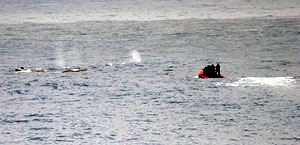

 | |||||||||||
|
|
Journals 2008/2009Heather Judkins
August 12, 2008 The marine mammals that we have been seeing have been incredible! I am practicing my amateur videotaping skills and I am hoping to bring back clips of many of these amazing animals. The survey being conducted is looking at the distribution and abundance of the marine mammals in the area off the western US coast as part of a long-term study. We are actually 160 miles off the California coast today as we follow our transect line. Similar to the STAR-LITE cruise I was on in November, this one has observers on the flying bridge from sun up to sundown looking through the big-eyes (large binoculars), hand-held binoculars, and our eyes for any mammal that crosses our path. As one is spotted, we then "close in" on the animal for photo identification, acoustics, and biopsy purposes. If it seems that the small boat will work to collect biopsies and pictures, the cruise leader chooses the team that will go and they prepare to launch the small boat. To date, the small boat has launched eight times. I have been fortunate to go out on the small boat twice so far for this cruise. Beaked whales, sperm whales, sei whales, blue whales, and fin whales have been some that we have launched on. We launched on fin whales (second largest whale species) and a blue whale when I was onboard. The small boat is quicker and more maneuverable than turning the 224 foot ship into position, so once it is unsecured from the ship, the small boat is off and running. They locate the animal via blows from the whale, slowly approach, and they take pictures and biopsies. I was assisting processing the biopsy samples. The team use crossbows with darts that have a biopsy tip on the end, which takes a small circle plug from the animals uppermost skin layers. Once we retrieve the dart, I have to carefully put the whole dart tip into a plastic bag, record the time, date and the collector's name. It then goes into a freezer bag until we get back onboard the ship to complete the process and the samples end up in the -80 degree freezer until we reach land. I put a new tip on the dart, being mindful not to touch it because of possible contamination, and pass it up to the bow to the biopsy team for another round.
The animals that we have launched on have been amazing! I felt so lucky to observe them from the flying bridge and when I was actually face to face with them at their level? Stunning. The fin whales are known as the "greyhounds of the sea" because of their speedy nature and they proved that as we followed one for biopsies. We had two of them within 20 feet of the boat cruising along coming up to the surface approximately every 4-6 minutes. The next time I was able to go on the boat, it was a single blue whale, which was gray, huge, and traveling in a steady line at a steady speed. We missed the biopsies but got photos taken for identification. This whale was up at the surface for four to five breaths before it fluked going under! Absolutely awesome to watch these graceful animals in their habitat.
|
||||||||||

